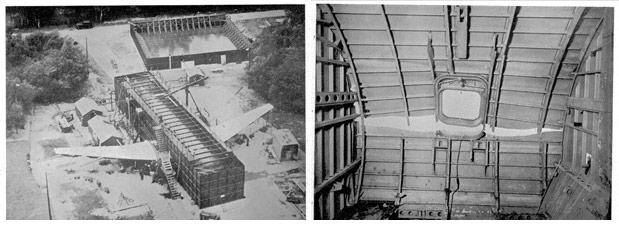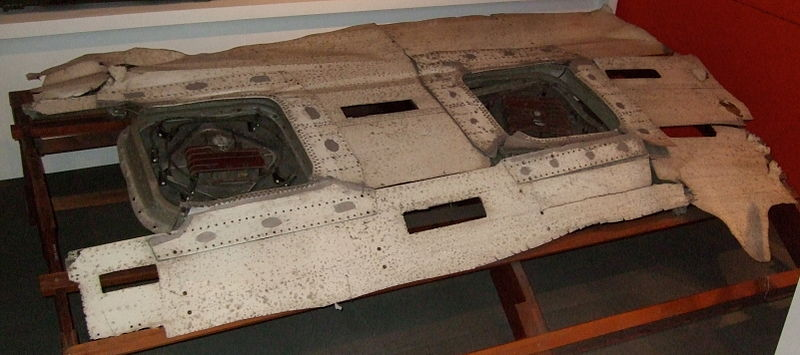Sure, Economists Have Sunk the World; Just be Happy They Don't Design Airplanes!
Anyone who has simply leafed through a modern economics textbook is struck by the large number of formulas and graphs. Certainly, all the great economists of the past - Adam Smith, David Ricardo, Carl Menger, Eugen Bohm von Bawerk, Benjamin Anderson and Wilhelm Ropke - would be dumbstruck by the mathematical density of a modern economic textbook. These men always considered economics a branch of moral philosophy, completely ill-suited to mathematical analysis. Indeed, a modern textbook in economics has far more in common with an engineering textbook than an economic text from the past.
However, as will be discussed here, the visual similarities of their textbooks notwithstanding, there is an enormous gap between the engineering and economics professions. This will clearly be seen by contrasting how each profession responded to a crisis in their field; engineers with the Comet disaster of the early 1950s and economists with the 2008 financial crisis.
The Comet and the Response of the Engineering Community
On May 2, 1952 the British Overseas Airline Company, (BOAC), forerunner to today's British Airways, introduced commercial jet airline service with the de Havilland Comet. Comet pilots soon became used to huge throngs of people standing outside of airports just to see the Comet takeoff and land. With its sleek design - which included integrating the four 5000-lb thrust Ghost jet engines in the wing - the plane was science fiction come to life.

However soon after it began commercial service, the Comet began to suffer a rash of crashes;
- 26 OCT 1952, Rome; BOAC Flight 115 skidded off a runway, no fatalities but the plane was a total loss
- 03 MAR 1953, Calcutta; a Comet breaks apart minutes after takeoff into bad weather, 11 people killed
- (Both accidents were blamed on pilot error and the Comet's wing was redesigned)
- 10 JAN 1954, Rome; BOAC Flight 781 crashes 20-minutes after take-off, 35-people killed
- (Comets temporarily grounded by BOAC, but service is soon restored)
- 08 APR 1954, Rome South African Air Flight 201 leaving Rome crashes into the sea near Naples. After this crash, the Comet's airworthiness certificate was revoked and the Comet ceased commercial operation
The Rome crash of January 1954 was especially haunting. The crash occurred while the pilot was talking with air traffic controllers and the discussion was broken mid-sentence. The plane had obviously suffered a sudden and catastrophic failure. The British aviation establishment checked and rechecked the Comet's design and gave the Comet a clean bill of health. With the April 1954 failure, it became clear that something was fundamentally wrong with the Comet, her elegant design and beauty notwithstanding. As a result of a herculean effort by the Royal Navy, large portions of the Flight 781 crash were found. In addition, bodies recovered from the crash were all found to have severe trauma. This was a key piece to the puzzle.
When a plane flies at high altitude - and Comets routinely flew at more than 30,000-ft - the plane's cabin must be pressurized. Atmospheric pressures at these altitudes are very low and the air is far 'too thin' for people to breathe. Cabins are pressurized to duplicate the atmosphere that would exist at around 8,000-ft altitude. As a result, there is considerably more pressure acting on the inside of an airliners cabin than there is on the outside. A jet airliner can be likened to a balloon that contains a higher pressure of air inside of it than exists on the outside of it.
Each time an airliner takes off and lands, the plane's fuselage is subjected to a stress cycle because of the pressure difference that exists at cruising altitudes. Metals can fail from otherwise low loads if the loads are repeatedly applied and released; this is called metal fatigue. (You can see this phenomenon with a paper clip by simply bending it back and forth until it breaks.) The trauma observed on the bodies of the Flight 781 victims was a clear sign that Comets were suffering an 'explosive decompression' at high altitude. The pressurized hull of the plane was essentially bursting like a balloon, and passengers were being hurtled against the plane's structure as the plane disintegrated in mid-air.
Comet engineers were dumbstruck. They understood metal fatigue and had tested the Comet to survive repeated stress cycles from take-offs and landing. In fact, the Comet had been designed for 10,000 take-off and landings but had been tested to the equivalent of 16,000 take-off and landings before suffering a structural failure. What could possibly be going on?
Well, unlike economists, when engineers realize they made a mistake, they move heaven and earth to determine what the mistake was. A Comet was put into a water tank where the stress cycles from taking off and landing would be simulated. See figure below. Water is much less compressible than air. As a result, when water is pressurized much less energy is stored in the water. (Imagine trying to compress a spring; with a spring that you can compress, you can get energy back when you release your grip and the spring expands. When you can't compress the spring, there is no energy to speak of stored in the spring. Releasing your grip in this case doesn't lead to any movement of the spring.) The advantage of using water during the test was, once a failure in the structure occurred, there would be no remaining energy left in the water to tear the entire plane apart. It should then be relatively straightforward to determine where the failure started.
Comet Tank Testing

On June 24, 1954 instruments in the test bed showed that pressure in the tank had been lost. The tank was drained and the Comet inspected. A huge tear was observed at one of the escape hatches. See the figure immediately above. This failure was then compared to a portion of the wreckage from Flight 781. The wreckage indicated that this plane had broken up as a result of a failure originating at the similarly shaped Automatic Direction Finder (ADF) antenna opening. See the figure below.
Flight 781 Failure

Now that the origin of the failure was known, a complete understanding of why the failure was occurring could be obtained. Engineers had understood that changes in shape lead to 'stress concentrations' that produce much higher levels of stress near these changes in shape than those that exist elsewhere in the structure. The fact that both failures - the test bed failure and the failure from Flight 781 - originated at the corner of a square window was not a coincidence. Clearly, the stresses in these corners were much higher than those calculated by the engineers. However, what of the testing that showed the fuselage was good for 16,000 take-off and landings? Flight 781 had only about 1,000 take-off and landings when it catastrophically failed. The structure that failed in the water tank had only 'seen' just over 3000 simulated take-off and landings. What was the explanation for this?
When de Havilland was testing their design they performed two tests; a 'proof' test and an endurance test to simulate fatigue loads. The proof test pressurized the plane's structure to well over two-times its normal working pressure. This same fuselage was then subjected to the endurance test which revealed the 16,000 cycle life. What then explains planes catastrophically failing in service with just 1,000 cycles? The problem was using the same fuselage for proof testing and endurance testing. When the fuselage was exposed to the high pressure during the proof test, its resistance to fatigue failure was greatly increased. (This is a process called 'strain hardening.') The Comet engineers hadn't realized this. Because production Comets were not given the proof test, they didn't have this improved fatigue resistance of the design fuselage and failed much earlier in service.
The lessons learned from the Comet were soon spread throughout the aviation industry. In addition, to forever eliminating square windows from airliners, it also became clear that airframe testing needed to better simulate actual operating conditions. While a proof test of a fuselage is still performed, this test is performed on a different fuselage than the one used for the endurance or fatigue testing. More generally, an entirely new engineering field, fracture mechanics, was born. In 1963, the paper describing the seminal Paris-Erdogan law - which modeled how a fatigue crack grows - was published. With this paper, the floodgates were open and the field rapidly expanded. As a result, a much better - albeit still hardly complete - understanding of how cracks propagate in structures is available today than when the Comet was designed. Knowledge had been gained but it had been obtained at a very steep price.
Paris-Erdogan Law of Crack Growth

The 2008 Crisis and the Response of the Economics Community
As will be discussed now, there is no comparison between the reaction of engineers to the Comet disaste with the response of the economics community to the 2008 financial crisis. Before discussing this response - or lack thereof - it is useful to revisit the predictions from three leading economists just before the crisis peaked in September 2008. All three economists have MIT PhDs and all have taught at Ivy League universities;
Ben Bernanke (chair of economics department, Princeton, Fed chair)
"....I was reassured to hear that most participants think that a decline in housing will be cushioned by strong fundamentals in terms of income, jobs, and continuing low interest rates. The labor market is clearly continuing to strengthen...I agree with most of the commentary that the strong fundamentals support a relatively soft landing in housing." (March 27-28, 2006, the first FOMC meeting he chaired)
Frederick Mishkin (professor Columbia, vice-chair FOMC)
"Since the spring of 2006, however, the expansion of the US economy appears to have been undergoing a transition to a more moderate and sustainable pace....Looking ahead, the most likely outcome for the coming quarters is, in my judgement, a continued moderate rate of economic expansion accompanied by some easing of pressure on resources...I continue to believe that the current stance of monetary policy is likely to foster sustainable economic expansion." (Speech at Bard College, April 20, 2007)
Jeremy Siegel (professor Wharton, omnipresence on CNBC)
"I think the actual number of delinquencies next year will be below what the market predicts, as investors have overreacted to the mortgage crisis. (emphasis added) When this happens it could lead to a nice recovery in financial stocks... And I believe that financial stocks, which have plummeted 18% so far this year, will outperform the S&P500 index next year as the crisis faces..." (Yahoo Finance, December 14, 2007)
Unlike the Comet disaster, there wasn't any effort by MIT to review its teaching methods to redress the obvious gaps in knowledge MIT graduates clearly had. Nor was there an effort by the Fed - Bernanke and Mishkin were both on the FOMC when quoted here - to review what it might have gotten wrong in the crisis. Finally - and most importantly - there was no effort by any of the individuals quoted here - Bernanke, Mishkin or Siegel - to admit a mistake or individual failing on their part.
Concluding Remark:
It is this lack of individual accountability - more than anything else - that proves just how empty the study of economics and those who study it have become, at least among so-called 'elite' schools and at the Fed. It is a complete misnomer to refer to economics as a profession or a legitimate field of inquiry, at least as it is practiced today among elite school graduates today. Instead, the study of economics at schools like MIT and Harvard is clearly fraudulent and its chief practitioners are little more than over-educated charlatans. The contrast between the Comet disaster and the financial crisis of 2008 conclusively demonstrates this.
Peter Schmidt
Sugar Land, TX
January 12, 2020
PS - As always, if you like what you read, please register with the site. It just takes an e-mail address and I don't share this e-mail address with anyone. The more people who register with the site, the better case I can make to a publisher to press on with publishing my book. Registering with the site will give you access to the entire Confederacy of Dunces list as well as the financial crisis timeline.
Help spread the word to anyone you know who might be interested in the site or my Twitter account. I can be found on Twitter @The92ers

